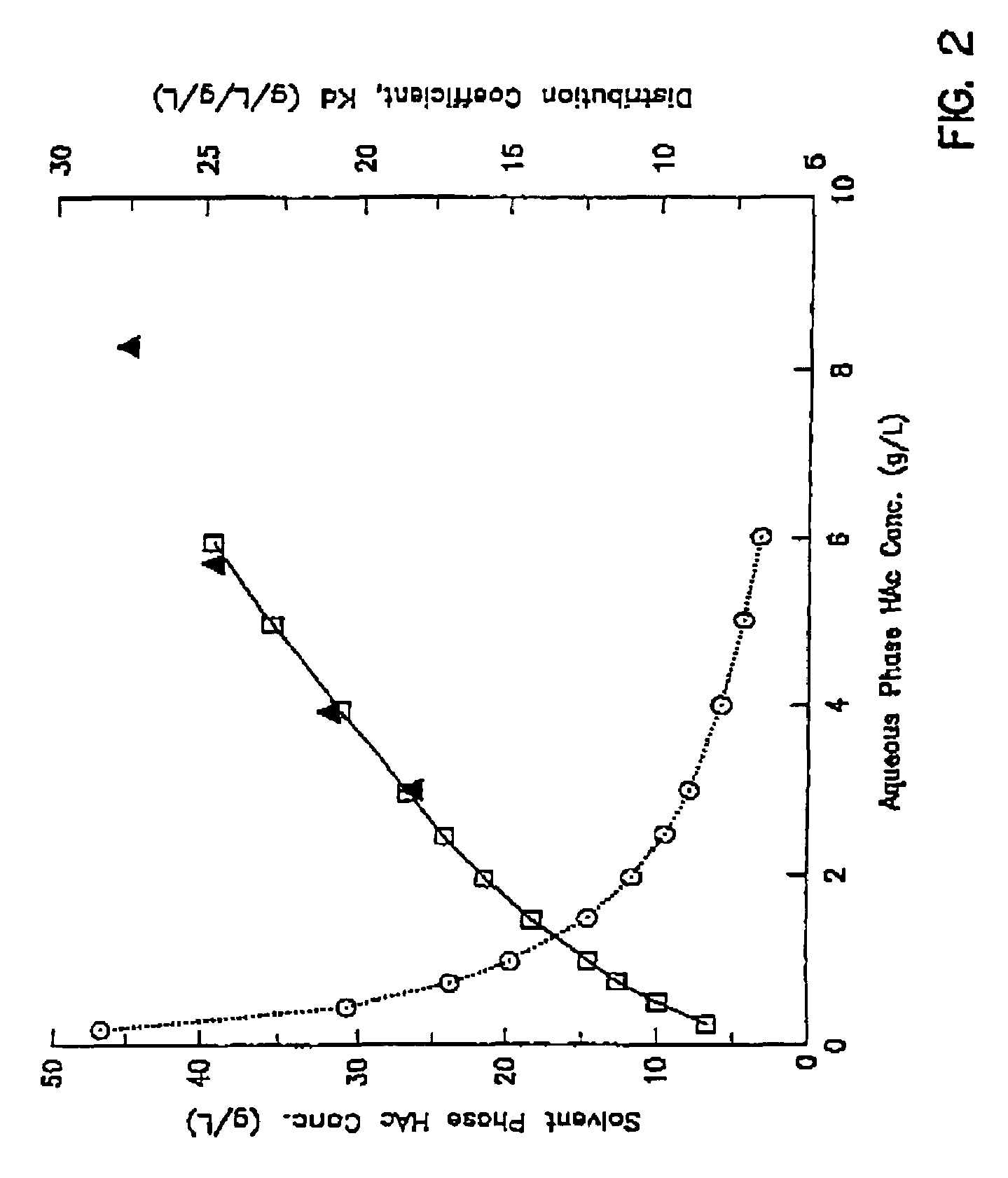Microbial process for the preparation of acetic acid, as well as solvent for its extraction from the fermentation broth
a technology of acetic acid and fermentation broth, which is applied in the field of improved methods for the production of acetic acid by microorganisms, can solve the problems of limited acetic acid production, achieve the effects of reducing temperature, avoiding oxidative degradation of solvent or solvent/cosolvent mixture, and reducing the temperatur
- Summary
- Abstract
- Description
- Claims
- Application Information
AI Technical Summary
Benefits of technology
Problems solved by technology
Method used
Image
Examples
example 1
Recovery of Acetic Acid from the Fermentation Product Stream Using the Solvent / Azeotroping Cosolvent Mixture of the Invention
A. 60% Modified Solvent A and 40% Orfom® SX-18 Cosolvent
[0093]An apparatus and method for producing acetic acid from a variety of aqueous gaseous streams is described in detail in published International Patent Application No. PCT WO98 / 00558, incorporated by reference herein. The process described therein is modified according to one aspect of the present invention, as follows.
[0094]A gas stream containing 45% carbon monoxide, 45% hydrogen and 10% carbon dioxide was introduced into a continuous stirred tank fermenter containing C. ljungdahlii strain ER12 and suitable nutrient medium. The liquid product stream from the fermenter with cell recycle (i.e., cell separation utilizing a hollow fiber membrane) containing 5 g / l free acetic acid and 5 g / l acetate at pH 4.75 (i.e., the cell-free stream) was sent to a multi-stage countercurrent extraction column. In the e...
example 2
Amide Formation
[0102]This example demonstrates the basis for the invention, that is, determination by the inventors that temperature control is vital to the efficient functioning of an amine-containing solvent in an acetic acid production process when an amine-containing solvent is employed in distillation and extraction steps.
[0103]The amide formation from amine in the solvent is a first order rate expression in acetic acid concentration illustrated by the formula: Y=kX, where Y represents amide concentration after 16 hours, measured in weight percent; X=acetic acid concentration after 16 hours, measured in weight percent, and k=the amide formation rate constant.
[0104]The rate of amide formation and thus the rate constant, k, increases with temperature by an Arrhenius type rate expression, represented by the formula:
ln(k)=−9163.21(1 / T)+27.41, where T=the absolute temperature in Kelvin.
[0105]FIG. 4 illustrates a plot of ln(k) as a function of the inverse absolute temperature which i...
example 3
Direct Extraction of Acetic Acid Using a Continuous Solvent Phase Column
[0106]Fermentation broth obtained from a fermenter similar to that of Example 1 contained 2.6 g / l cells (dry weight), excess nutrients, 5 g / l acetic acid and 5.0 g / l acetate at pH 4.75. This broth is sent to a continuous solvent phase extraction column containing 60% Adogen283®LA (Witco) solvent in SX-18 cosolvent. The extraction column is a cylindrical column, packed or unpacked, which has entrances and exits for solvent and aqueous phase culture. Culture flows downward through the solvent filled column, and solvent flows upward, countercurrent to the culture. The exiting solvent from the column contains 50 g / l acetic acid and is sent to distillation for acid recovery prior to recycle back to the column. The exiting culture stream at the bottom of the column contains 5.0 g / l acetate, 0.5 g / l acetic acid, cells and nutrients and is sent back to the fermenter as recycle. Because the solvent and culture are immisc...
PUM
| Property | Measurement | Unit |
|---|---|---|
| temperature | aaaaa | aaaaa |
| pressure | aaaaa | aaaaa |
| temperature | aaaaa | aaaaa |
Abstract
Description
Claims
Application Information
 Login to View More
Login to View More - R&D
- Intellectual Property
- Life Sciences
- Materials
- Tech Scout
- Unparalleled Data Quality
- Higher Quality Content
- 60% Fewer Hallucinations
Browse by: Latest US Patents, China's latest patents, Technical Efficacy Thesaurus, Application Domain, Technology Topic, Popular Technical Reports.
© 2025 PatSnap. All rights reserved.Legal|Privacy policy|Modern Slavery Act Transparency Statement|Sitemap|About US| Contact US: help@patsnap.com



